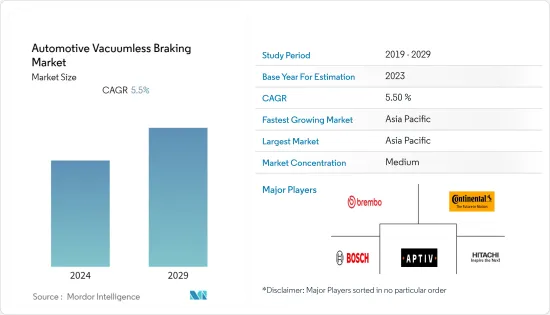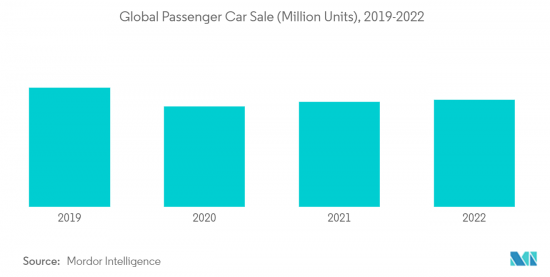 |
市場調查報告書
商品編碼
1406218
汽車無真空煞車:市場佔有率分析、產業趨勢/統計、成長預測,2024-2029Automotive Vacuumless Braking - Market Share Analysis, Industry Trends & Statistics, Growth Forecasts 2024 - 2029 |
||||||
※ 本網頁內容可能與最新版本有所差異。詳細情況請與我們聯繫。
汽車無真空煞車市場目前的市場規模為28.5億美元,預計未來五年將成長至39.3億美元,預測期內收益複合年成長率為5.5%。

從中期來看,推動煞車技術發展的主要因素將是減輕每個車輪重量的需求,以提高效率並透過再生煞車來回收和散發熱量。自動駕駛汽車的成長需要密集且聰明地使用煞車和轉向技術,預計將對市場產生積極影響。
除了駕駛輔助系統之外,混合和電動驅動器相對於傳統引擎的出現也需要煞車系統的無真空煞車解決方案。由於小客車、卡車、公共汽車和其他商用車產量的增加,該行業正在不斷發展。市場價值受到道路條件改善、新建和擴大基礎設施發展舉措的正面影響。
電動輔助煞車正在支持自動駕駛的發展。隨著汽車的自動化程度越來越高,電動煞車可以提供精確的煞車操作。電動增壓可以更快地形成液壓,因此,市場在預測期內可能會顯著成長。
汽車無真空煞車市場趨勢
小客車預計將佔據無真空煞車市場的主要佔有率
全球小客車銷量不斷增加,全球對小客車的需求也可能增加。 2022年,全球小客車銷量約5,748萬輛,較2021年成長2%。
此外,可支配收入的增加和技術創新正在推動所研究市場的成長。豪華車數量的大幅增加以及消費者對轎車和 SUV偏好的下降正在推動全球對小客車及其豪華設施的需求。
此外,為了應對日益嚴重的環境問題和不斷上漲的汽油價格,頂級豪華汽車製造商正在推出電動車型。預計這也將有助於擴大市場。
汽車製造商和邦政府正在共同努力加強印度的混合動力汽車技術。因此,印度混合動力汽車市場在評估期間獲得了巨大的吸引力。例如
- 2022 年 8 月,豐田宣布將投資 360 億盧比(432,946 美元)在卡納塔克邦的 Bidai 工廠生產混合動力汽車。此外,這項投資計畫是在州政府允許開始生產混合動力汽車後宣布的。
印度公司也正在進行研發活動,以開發新產品,這將對預測期內目標市場的成長產生正面影響。例如
- 2022年8月,印度最大汽車製造商馬魯蒂SUZUKI宣布將於年終推出首款電動車。母公司SUZUKI汽車公司還將在古吉拉突邦投資 10,400 盧比(1,250,768 美元)建造一座生產電動車的製造工廠。
由於上述全球發展,小客車市場可能在預測期內顯著成長。

快速成長的亞太市場
預計在預測期內,亞太地區的汽車無真空煞車市場將出現成長。中國、印度和日本是該區域市場的主要經濟體,預計在全球市場中將以更快的速度成長。中國是全球最大的汽車市場之一。
中國不斷成長的人口和不斷成長的可支配收入正在推動汽車需求。此外,中國較低的生產成本支撐著中國汽車製造業的成長。 2022年,中國小客車和商用車產量達2,686萬輛。
汽車無真空煞車製造商正在與市場參與企業合作,為未來車輛開發下一代煞車系統。
隨著中階可支配收入的增加,印度經濟正在擴張。這對汽車需求的成長產生了積極影響。印度較低的生產成本促使過去五年汽車產量快速成長。隨著汽車製造業的增加,汽車感測器市場也越來越受到關注。
隨著國家不斷實現車輛現代化,安全標準不斷提高,與國際標準接軌,該國汽車的平均車齡不斷增加,預計將增加售後市場對真空煞車的需求。
汽車無真空煞車產業概況
汽車無真空煞車市場由多家公司主導,包括羅伯特·博世有限公司、布雷博公司、大陸集團和安波福公司。先進技術、研發計劃投資增加以及電動和自動駕駛汽車市場不斷成長等因素是市場的主要驅動力。
其他福利:
- Excel 格式的市場預測 (ME) 表
- 3 個月的分析師支持
目錄
第1章簡介
- 調查先決條件
- 調查範圍
第2章調查方法
第3章執行摘要
第4章市場動態
- 市場促進因素
- 市場抑制因素
- 產業吸引力-波特五力分析
- 供應商的議價能力
- 買家/消費者的議價能力
- 新進入者的威脅
- 替代品的威脅
- 競爭公司之間敵對關係的強度
第5章市場區隔
- 依車型分類
- 小客車
- 商用車
- 依電動汽車類型
- 純電動車(BEV)
- 插電式混合動力汽車(PHEV)
- 其他
- 依銷售管道
- OEM
- 售後市場
- 依地區
- 北美洲
- 美國
- 加拿大
- 北美其他地區
- 歐洲
- 德國
- 英國
- 法國
- 其他歐洲國家
- 亞太地區
- 印度
- 中國
- 日本
- 韓國
- 其他亞太地區
- 其他地區
- 巴西
- 墨西哥
- 阿拉伯聯合大公國
- 其他
- 北美洲
第6章 競爭形勢
- 供應商市場佔有率
- 公司簡介
- Continental AG
- Robert Bosch GmbH
- Brembo SpA
- LSP Innovative Automotive Systems GmbH
- Aptiv PLC(Delphi)
- Disc Brakes Australia(DBA)
- Hitachi Automotive Systems
- Advics Co. Ltd.
- Performance Friction Corporation(PFC)Brakes
- Meritor Inc.
- Haldex AB
- Knorr-Bremse AG
第7章 市場機會及未來趨勢

The automotive vacuumless braking market was valued at USD 2.85 billion in the current year and is projected to grow to USD 3.93 Billion by the next five years, registering a CAGR of 5.5% in terms of revenue during the forecast period.
Over the medium term, the major factor propelling the development of brake technology is the demand for weight reduction per wheel for improved efficiency and recovery and dissipation of heat through regenerative braking. The growth in autonomous vehicles that will need intensive smart use of brake and steering technology is expected to positively affect the market.
The emergence of hybrid and electric drives over conventional engines, in addition to driver assistance systems, has the requirement of vacuumless braking solutions for the braking system. The industry is growing due to the increased manufacturing of passenger cars, trucks, buses, and other commercial vehicles. The market value is positively impacted by increasing road conditions and the construction of new ones, as well as expanding infrastructure development initiatives.
The electric-assist braking is supporting the growth of automated driving. As cars are becoming automated, electric brake operates the brakes precisely. An electric boost can form hydraulic pressure more quickly, which in turn is likely to witness major growth for the market during the forecast period.
Automotive Vacuumless Braking Market Trends
Passenger Cars is expected to hold the major share in Vacuumless Braking Market
A rise in the sale of passenger car sales across the globe is likely to enhance the demand for passenger cars across the globe. In 2022, around 57.48 million passenger cars were sold across the globe, which witnessed a 2% growth in sales as compared to 2021.
Additionally, an increase in disposable income and technological innovation drives growth in the market studied. The significant increase in the number of luxury vehicles and the decrease in consumer preference for sedans and SUVs have boosted the global demand for passenger cars and their premium amenities.
Furthermore, in response to growing environmental concerns and rising gasoline prices, top luxury automobile manufacturers are launching electrified models of their vehicles. This will also likely aid in the expansion of the market studied.
OEM and state government are working together to robust the hybrid vehicle technology in India. This has helped India's hybrid vehicles market gain significant traction during the assessment period. For instance,
- In August 2022, Toyota Motors announced that it was to invest Rs. 3,600 crores (USD 432946) for manufacturing a hybrid vehicle facility in Karnataka at the Bidai facility. Moreover, the investment plan came out after the State government provided a green signal to start the production of hybrid vehicles.
Indian companies are also working on research and development activities to develop new products that would positively impact the target market growth during the forecast period. For instance,
- In August 2022, India's largest automaker, Maruti Suzuki, confirmed that it shall soon introduce its first electric vehicle by 2025 end. In addition, Its parent firm, Suzuki Motor Corporation, is looking forward to investing Rs 10,400 crore (USD 1250768) in Gujarat to build a manufacturing plant to produce electric vehicles.
With the development mentioned above across the globe, the passenger cars market is likely to witness major growth during the forecast period.

Asia-Pacific being the Fastest Growing Market
In the automotive vacuumless braking market, the growth of the Asia-Pacific region is expected to be more during the forecast period. China, India, and Japan are the major economies in the regional market that are anticipated to grow at a faster rate in the global market. China is one of the biggest automotive markets in the world.
The growing population and rising disposable incomes of people in China have increased the demand for vehicles in the country. Additionally, the low production costs in China have favored the growth of vehicle manufacturing in China. In 2022, China produced 26.86 million passenger and commercial vehicles.
The automotive vacuumless braking manufacturers are doing partnerships with other market participants to develop next-generation braking systems for their future vehicles. For instance,
- In June 2021, Bosch announced at its annual press conference that it would start manufacturing the "iBooster' electric brake booster in Japan in the latter half of 2022. 2021 marked the 110th anniversary of Bosch's business start in Japan. iBooster is a modern braking system that realizes high-performance braking functions such as compatibility with vacuumless systems, customized pedal feeling, improved collision damage mitigation braking performance, and redundancy under automated driving.
The Indian economy is expanding as there is a rise in the disposable income of middle-class consumers. This, in turn, has a favorable impact on the increasing demand for automobiles. Vehicle manufacturing has increased rapidly over the last five years as a result of the country's cheap production costs. The automotive sensor market is gaining traction as vehicle manufacturing increases.
With the growing modernization of vehicles in the country and the rise in safety standards in line with international standards, the average age of vehicles in the country is increasing, which would enhance the demand for vacuumless brakes in the aftermarket segment.
Automotive Vacuumless Braking Industry Overview
The automotive vacuumless braking market is consolidated and majorly dominated by a few players, such as Robert Bosch Gmbh, Brembo S.p.A., Continental AG, and Aptiv PLC, amongst others. Factors like advanced technology, growing investment in R&D projects, and a growing market of electric and autonomous vehicles highly drive the market. To provide more quicker brake response to the driver, major automotive vacuumless braking manufacturers are developing future brake technology and expanding their market reach. For instance,
In September 2022, Robert Bosch started production of the iBooster electric brake booster began at the Tochigi Plant. The company invested USD 0.022 billion (JPY 3 billion) in the Tochigi Plant, which manufactures ABS (antilock braking system) and ESC (electronic stability control), to install production facilities and set up a dedicated production line for the iBooster. iBooster realizes high-performance braking functions such as compatibility with vacuumless systems.
In July 2022, BMW introduced a vacuumless braking system in BMW M models. Through this system, the company enhanced its vehicle performance.
Additional Benefits:
- The market estimate (ME) sheet in Excel format
- 3 months of analyst support
TABLE OF CONTENTS
1 INTRODUCTION
- 1.1 Study Assumptions
- 1.2 Scope of the Study
2 RESEARCH METHODOLOGY
3 EXECUTIVE SUMMARY
4 MARKET DYNAMICS
- 4.1 Market Drivers
- 4.2 Market Restraints
- 4.3 Industry Attractiveness - Porter's Five Forces Analysis
- 4.3.1 Bargaining Power of Suppliers
- 4.3.2 Bargaining Power of Buyers/Consumers
- 4.3.3 Threat of New Entrants
- 4.3.4 Threat of Substitute Products
- 4.3.5 Intensity of Competitive Rivalry
5 MARKET SEGMENTATION
- 5.1 By Vehicle Type
- 5.1.1 Passenger Cars
- 5.1.2 Commercial Vehicles
- 5.2 By Electric Vehicle Type
- 5.2.1 Battery Electric Vehicle (BEV)
- 5.2.2 Plug-in Hybrid Electric Vehicle (PHEV)
- 5.2.3 Other Electric Vehicle Types
- 5.3 By Sales Channel Type
- 5.3.1 OEM
- 5.3.2 Aftermarket
- 5.4 By Geography
- 5.4.1 North America
- 5.4.1.1 United States
- 5.4.1.2 Canada
- 5.4.1.3 Rest of North America
- 5.4.2 Europe
- 5.4.2.1 Germany
- 5.4.2.2 United Kingdom
- 5.4.2.3 France
- 5.4.2.4 Rest of Europe
- 5.4.3 Asia-Pacific
- 5.4.3.1 India
- 5.4.3.2 China
- 5.4.3.3 Japan
- 5.4.3.4 South Korea
- 5.4.3.5 Rest of Asia-Pacific
- 5.4.4 Rest of the World
- 5.4.4.1 Brazil
- 5.4.4.2 Mexico
- 5.4.4.3 United Arab Emirates
- 5.4.4.4 Other Countries
- 5.4.1 North America
6 COMPETITIVE LANDSCAPE
- 6.1 Vendor Market Share
- 6.2 Company Profiles*
- 6.2.1 Continental AG
- 6.2.2 Robert Bosch GmbH
- 6.2.3 Brembo S.p.A.
- 6.2.4 LSP Innovative Automotive Systems GmbH
- 6.2.5 Aptiv PLC (Delphi)
- 6.2.6 Disc Brakes Australia (DBA)
- 6.2.7 Hitachi Automotive Systems
- 6.2.8 Advics Co. Ltd.
- 6.2.9 Performance Friction Corporation (PFC) Brakes
- 6.2.10 Meritor Inc.
- 6.2.11 Haldex AB
- 6.2.12 Knorr-Bremse AG










